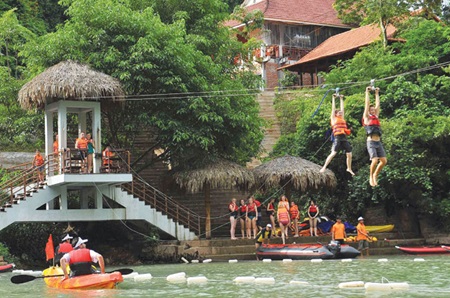
The number of foreign tourists visiting Viet Nam has grown over the last three months, following a 13-month decline due to disease, unstable economies and fierce regional competition.
The number of foreign tourists visiting Viet Nam has grown over the last three months, following a 13-month decline due to disease, unstable economies and fierce regional competition.
 |
| Foreign tourists enjoy activities in the central province of Quang Binh. The number of foreign tourists visiting Viet Nam has grown over the last three months, following a 13-month decline due to disease, unstable economies and fierce regional competition. |
During a press conference held yesterday to review the results of the past few months' tourism improvement strategies, Nguyen Van Tuan, director general of the Viet Nam National Administration of Tourism (VNAT), said he was optimistic the country's tourism sector would recover.
From now until the end of this year, Viet Nam would try its best to promote its tourism marketing campaign and hold tourism fairs abroad to welcome at least the same number of tourists as last year – 7.8 million.
In the first haft of the year, the number of foreign tourists to the country decreased 12 per cent, compared with last year. But in July, August and September, the number of foreign tourists coming to Viet Nam increased.
In September, international visitors to the country reached 626,000, an 8.3 per cent increase over last year.
About 5.7 million tourists came to Viet Nam during the first nine months of the year, marking a decrease of 5.9 per cent on the year.
"We hope that in the next three months, with this trend, tourism will continue to develop," Tuan said. "If we achieve this result, it is due to big efforts from the tourism sector."
Along with an increase in the number of domestic travellers, the country earned VND270 trillion (US$12 billion) from tourism, an increase of 2.8 per cent on the year.
Viet nam started scrapping visas for visitors from six more European countries – Germany, France, Italy, Spain, England and Belarus – in July, aiming to draw in more tourists.
To attract more Westerner tourists, Tuan said he would ask the Government to extend the amount of time the tourists with visa exemptions could stay. According to the current rules, the visa exemption granted to those countries allows visitors one 15-day stay per year.
Moreover, within the next three months, the country will promote its e-marketing and be more active in promoting its image abroad. It will organise road shows in China (is responsible for a fourth of the international tourists coming to Viet Nam), Singapore, France, Germany and Spain.
From October 20 to December 20, a 30-second ad showcasing Viet Nam's rich culture and stunning landscapes will be shown on the UK's Travel Channel.
Tuan said he would welcome all foreign filmmakers to Viet Nam to shoot scenes for their movies.
Beautiful images of Vietnamese landscapes from Ha Long Bay and Ninh Binh to En Cave appeared in Warner Bros' second film trailer for Peter Pan.
Son Doong Cave in Quang Binh Province also appeared on the US show Good Morning America.
To lure more tourists, the Ministry of Culture, Sports and Tourism will organise National Tourism Year 2016 – Phu Quoc – the Mekong Delta. It will begin in April.
Over the last nine months, Viet Nam organised several programmes to promote tourism in Singapore, Indonesia, India, China, and Slovakia. It also invited international journalists to Viet Nam.
In 2015, Viet Nam made it in the list of Telegraph readers' top 20 favourite countries.
Almost 90,000 travellers of the UK's famous newspaper, the Telegraph, have voted Viet Nam among the top 20 most impressive and fascinating destinations throughout the world.
Master plan
Also yesterday, the Ministry of Culture, Sports and Tourism organised a conference, announcing the Government's newly issued decision to develop culture, family, exercise, sports and tourism in the southeastern region by 2020.
A ministry representative said the master plan aimed to make full use of the potential of the resources and technical infrastructure in the region.
It would create a driving force for the development of culture, family, physical exercise, and tourism.
A ministry representative told the conference held in Dong Nai Province that the plan also aimed to strengthen regional linkages based on the advantages of each - and to reinforce co-operation with ASEAN countries to accelerate the development of regional culture, sports and tourism.
Government decision No. 1400/QD-TTg dated August 18, indicates that HCM City is the nation's main centre for culture, arts, scientific study and human resource training.
This meant that the development of the East-West cultural axis would boost co-operation in culture and arts among provinces.
By the year 2020, the southern region is expected to welcome more than six million international visitors and about 34 million locals, earn up to VND170 trillion (US$7.6 billion) from tourism services and create jobs for more than 200,000 labourers.
(Source:VNS)





